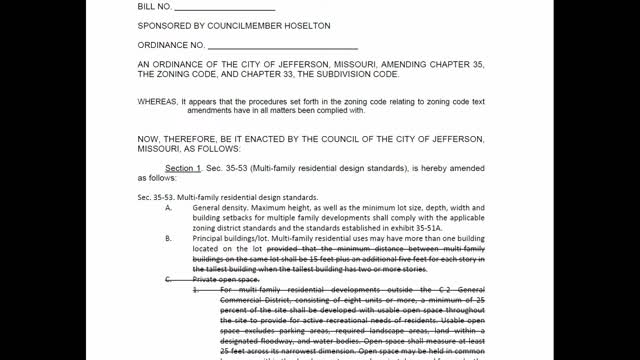City proposes major zoning changes to boost housing development
August 09, 2024 | Jefferson City, Cole County, Missouri

This article was created by AI summarizing key points discussed. AI makes mistakes, so for full details and context, please refer to the video of the full meeting. Please report any errors so we can fix them. Report an error »

In a recent government meeting, officials discussed several proposed amendments to local zoning codes aimed at enhancing residential development and addressing community needs. Key proposals include reducing the width of the pole portion of flag lots from 35 feet to 30 feet, which would facilitate the creation of more flag lots—properties connected to the street by a narrow strip of land. This change is particularly significant given the terrain of the area, where flag lots often represent the only viable option for property development.
Another notable proposal involves the removal of separation requirements between accessory structures, such as garages, and primary residences. This change is expected to streamline construction processes and provide homeowners with greater flexibility in property use.
Additionally, the meeting addressed the conversion of former single-family homes, now used for commercial purposes, back to residential use without the need for rezoning. This move aims to restore residential character in neighborhoods where such conversions have occurred.
The council also discussed reducing parking requirements for multifamily apartment complexes, which could alleviate some of the constraints currently faced by developers. Furthermore, the proposal includes allowing three- and four-unit residential structures to have their lots divided, enabling individual ownership of yard areas.
A significant point of contention was the existing requirement for multifamily developments to allocate 25% of their site for usable open space. Officials argued that this requirement is overly burdensome and suggested that developers should have the discretion to determine the amenities they provide, rather than being mandated to meet a specific percentage.
Lastly, the meeting proposed adjustments to setback requirements between buildings on the same property, which currently can lead to excessive spacing that exceeds standard regulations. By relying on existing building and fire codes for safety, the proposed changes aim to modernize outdated zoning regulations that date back several decades.
These proposed amendments reflect a broader effort to adapt local zoning laws to contemporary needs, promoting residential development while maintaining community standards.
Another notable proposal involves the removal of separation requirements between accessory structures, such as garages, and primary residences. This change is expected to streamline construction processes and provide homeowners with greater flexibility in property use.
Additionally, the meeting addressed the conversion of former single-family homes, now used for commercial purposes, back to residential use without the need for rezoning. This move aims to restore residential character in neighborhoods where such conversions have occurred.
The council also discussed reducing parking requirements for multifamily apartment complexes, which could alleviate some of the constraints currently faced by developers. Furthermore, the proposal includes allowing three- and four-unit residential structures to have their lots divided, enabling individual ownership of yard areas.
A significant point of contention was the existing requirement for multifamily developments to allocate 25% of their site for usable open space. Officials argued that this requirement is overly burdensome and suggested that developers should have the discretion to determine the amenities they provide, rather than being mandated to meet a specific percentage.
Lastly, the meeting proposed adjustments to setback requirements between buildings on the same property, which currently can lead to excessive spacing that exceeds standard regulations. By relying on existing building and fire codes for safety, the proposed changes aim to modernize outdated zoning regulations that date back several decades.
These proposed amendments reflect a broader effort to adapt local zoning laws to contemporary needs, promoting residential development while maintaining community standards.
View full meeting
This article is based on a recent meeting—watch the full video and explore the complete transcript for deeper insights into the discussion.
View full meeting
